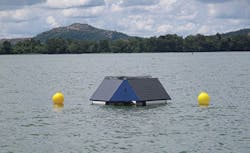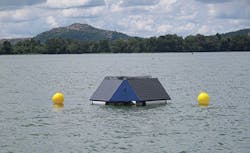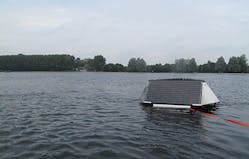By Dr. Orren Schneider
As much of North America has seen warmer summers, growth of algae in many surface water supplies has increased. Additionally, the 2009 National Lakes Assessment from the Environmental Protection Agency has estimated that 20 percent of the nation's lakes are highly impacted by algae, and one-third contain some level of harmful algal toxins. This presents a challenge for water treatment plants trying to control algae blooms, which can create problems for performance and increasing operating expenditure for cleaning and maintenance activities.
Challenge
American Water's New Jersey subsidiary operates the Canoe Brook Water Treatment Plant in Short Hills, N.J. The reservoirs that serve as the plant's water supply are shallow and, due to nutrient loading, also eutrophic. This combination of factors leads to seasonally severe algae blooms, which in turn can lead to customer complaints of unpleasant tastes and odors (T&O). While these are aesthetic and not a cause for health concerns, they nevertheless can negatively impact customer satisfaction with service.
Typically, the algae present in the lake were treated with copper sulfate, a compound toxic to algae and other aquatic life. However, this compound is expensive and can lead to the development of copper-resistant algal strains. Further, the use of chemical algaecides can cause cell lysis, leading to the release of T&O compounds and/or harmful algal toxins.
Technology
As an alternative to copper-based algaecides, the use of ultrasonic treatment is sometimes used to control algae. Ultrasonic treatment uses high-frequency sound waves to attack the algal cells. The treatment is widely used in commercial and residential applications but is relatively new for municipal drinking water reservoirs.
In an effort to reduce costs, improve operations and reduce customer complaints, four solar-powered ultrasonic algae control buoys manufactured by LG Sonic (Netherlands) were installed in the Canoe Brook Reservoir No. 1. These buoys continuously transmit ultrasonic waves to disrupt algal cells, causing them to sink and prevent proliferation.
These emitters have been incorporated into a buoy system that uses on-board analytical capability and algorithms to determine the type of algae present and alters the emitted frequency to control the different species. Rather than cause cell lysis, the LG Sonic devices are targeted at the gas vesicles present in the algae, causing them to collapse and thereby reducing the buoyancy of the cells. This causes them to sink to the bottom of the reservoir.
At the bottom, less sunlight is available for photosynthesis, and the cells stop growing. If other species of algae begin to predominate, the frequency can be changed to deal with the new population. Because of these advances, much lower sonic intensities can be used and thus, the ultrasonic buoys are capable of being powered by on-board solar cells.
Because of the tunable emitter, a single device is capable of treating the range of algae that may be present in a water body, including cyanobacteria (blue-green algae), green algae and diatoms. The effective diameter of treatment using these buoys is approximately 500 meters (the effective area is approximately 50 acres). Because the algal cells are not lysed, metabolites (including T&O compounds, pigments and toxins) are contained within the cells and are not released into the water.
This was the first installation of this relatively new technology for drinking water reservoirs in North America. This new system combines online water quality monitoring, telemetering and ultrasound technology to better prevent T&O events from occurring. Additionally, in keeping with American Water's sustainability efforts, this system operates 100 percent on solar power, and the technology will not harm fish or other wildlife.
Results
Extensive testing conducted during 2014 showed that the buoys had a significant impact on the algae, reducing algal counts, raw water turbidity and total organic carbon in the water. This improved water quality, enabled the plant operations staff to reduce coagulant consumption by more than 20 percent and reduced the concentration of undesirable T&O-causing compounds in the raw water entering the plant.
Reduced chemical use resulted in lower filter effluent turbidity and significantly increased filter run lengths over the same period in 2013, all while pumping approximately 20 percent more water than the previous year. Based on the cost of the equipment and savings realized, it is estimated that the payback period for the buoys is less than two years.
Based on the results of this study, American Water has decided to purchase buoys for other reservoirs impacted by algae and is looking at other uses, including clarification basins, waste backwash lagoons and wastewater/reuse applications.
About the Author: Dr. Orren Schneider is a water technology manager with American Water, the largest publicly traded U.S. water and wastewater utility company. Schneider joined American Water in 2005 and is involved with research leading to optimization of water treatment and distribution system operations. His primary areas of focus include evaluation and design of advanced coagulation, clarification, filtration, disinfection, and membrane technologies. He has extensive experience with pilot plants that specialize in collection and analysis of data for scale-up to full-scale operations.
More WaterWorld Current Issue Articles
More WaterWorld Archives Issue Articles





